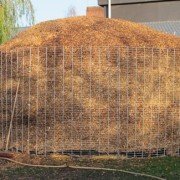Elektroschrott
E-Waste: A New Commodity. Is the future of Mining in landfills rather than in mines?
By Markus Haastert and Anne-Kathrin Kuhlemann
Problem: electronic waste in landfills
A recent report by the StEP Initiative comprehensively presents the findings of an ambitious study containing a large volume of previously unavailable data about the global accumulation of e-waste. The shocking outcome of this report is that by 2017, all of that year’s end-of-life refrigerators, TVs, mobile phones, computers, monitors, e-toys and other products with a battery or electrical cord worldwide are predicted to fill a line of 40-ton trucks end-to-end three quarters around the equator.
The report containing this frightening forecast was commissioned and compiled by the “Solving the E-Waste Problem (StEP) Initiative”, an innovative partnership of UN organizations, industry, governments, and non-government and science organizations. StEP was set up in an attempt to try to quantitatively understand and ultimately find solutions for a problem, which has a negative impact on the lives of more and more people around the globe. To illustrate the extent of the global e-waste problem, it is graphically portrayed in a novel format: the StEP E-Waste World Map.
Unfortunately, most of these no longer useful e-products are destined for disposal. However, gradually improving recycling initiatives in some areas are diverting some of them to recycling and reuse. The interactive map resource, which contains comparable annual data from 184 countries, shows the estimated output of electrical and electronic equipment put on the market and how much of it eventually will result in e-waste.
As the map shows, almost 48.9 million metric tons of used electrical and electronic products were accumulated in 2013, amounting to an average of 7 kg for each of the world’s 7 billion people. And the flood of e-waste is still growing. The StEP prediction is that, by 2017, the total annual volume will be 33 per cent higher at 65.4 million tons, which represents the weight of almost 200 Empire State Buildings or 11 Great Pyramids of Giza. Through this impressive effort of data collection, the magnitude of the problem becomes blatantly obvious.
Looking at the US, the news is similarly frightening: consumers discard more than 110,000 computers per day. E-waste is the fastest growing solid municipal waste type ending up in landfills or incinerators, with a rate of less than 10% of it being recycled. Worldwide computer sales in 2012 reached the 426 million mark. But what is even more alarming is that the production of electronic equipment consumes more energy, metals and chemicals than any other product in a modern household. The majority of the energy of electronic devices is actually consumed in making them (81%), and not in using them (19%).
In terms of metal content, E-waste has a higher concentration of metals on average than any other raw material, from which the metals have been extracted. It is a fact, that 1 metric ton of electronic computer scrap contains more gold than can be extracted from 17 tons of ore. A ton of used cell phones, good for 6,000 handsets, contains 3.5 kg of silver, 340 grams of gold, 140 grams of palladium, and 130 kg of copper. Japanese consumers alone have already discarded over one billion handsets, and with it 3,500 tons of silver.
Rather than committing these valuable resources to the ever-growing volume of landfills, it is more important than ever to work on creative solutions for their isolation and re-entry into the production process. This is exactly what metals without mining is about. The reason for this should not just be that many of the heavy metals featuring prominently in e-waste, such as mercury, lead, cadmium and flame retardants pose a real danger to public health, but also our growing awareness, that mining is extremely harmful to the environment, as stated in the MIT Mission 2016 report.
Innovation: bacterial extraction
One of the technologies used for the extraction of metals from manufactured products no longer in use is referred to as chelation, a chemical process, in which the affinity of certain bacteria for a specific metal is used for the extraction of the metal from an otherwise inaccessible environment.
Microorganisms have been active in the mobilization of metals from rocks, minerals and soil for millions of years. Living cells purify and process metals and make these available to produce enzymes, vitamins and genes. Living cells, then, have the ability to process metals. Better, living cells can recognize and bind specific metals and could therefore be used to extract pure metals out of discarded electronics, if they were previously ground down into small enough particles, without any expensive and technically challenging smelting process.
Prime Separations (USA), founded by Henry Kolesinski and Robert Cooley, former researchers with Polaroid and Waters Associates and experts in film technologies, developed and markets a simple machine that works through the continuous extraction of metals on a thin plastic sheet. They originally designed a small, low cost apparatus, with which they were able to show the viability of the process using crushed Japanese cell phones supplied by Dowa Mining. The energy cost is minimal, the separation technique operates at ambient temperature and pressure, the main energy input is the crushing of e-waste, with the mass manufacture of the film remaining a challenge. The aim, however, is the production of a system, which can process tons of e-waste per hour, instead of kilograms per day.
The first income of Prime Separations is the development of on-site metal recovery systems for administrative bodies keen to learn how to reduce the dramatic stockpile of e-waste and avoid toxic leaks. In order to put the common knowledge, that one ton of computers has a value of $15,000 in terms of the embedded metals, to work to our advantage, the installation of a network of on site processing units to convert this expensive and partly dangerous e-waste into a cash generating opportunity seems to be an exceedingly good idea.
These separation units should eventually be installed on each landfill site, or e-waste deposit. They will generate revenue and reduce the strain on site. Advantages are obvious: the lifetime of the landfill is extended, the risk of soil contamination and leaking toxins into the water table is reduced. Cost of land in and around landfills is negligible and the resources are delivered to the doorstep more or less for free. A solid income from the final processed metal is guaranteed. With the implementation of this innovation the mining of landfills will have become a reality. Not just will the stream of non abating e-waste restock the commodity necessary for the process, our waste, but landfills grown over years, even decades, contain so much value that it should be worth to excavate them.
This relatively inexpensive technology also provides developing countries with the opportunity to eliminate e-waste, stimulating the creation of metal processing facilities like the one proposed by Prime Separations. If we take into account the reduction of demand for steel and titanium due to the introduction of silk geometry, and combine this with a proposed recovery level of 99.98% pure metals, including the toxic ones, we can start to see how this reduces costs and increases revenues, while generating jobs that are healthy and building up social capital.
Potential: from mining to recovery
There are many more innovative approaches in the field of e-waste mining. One of the possibilities is the bioleaching of polymetallic industrial waste using chemolithotrophic bacteria. Another promising contribution in materials research comes from the group of Manchester University lecturer A. Vijayaraghavan, looking into ways to make the required film material more accessible.Some reports also suggests to use stockpiling until the necessary technology has caught up with the demands of the e-waste management problem. Considering recent advances, it should not be too long from now.

Most research for now focuses on strategic metals, but it is obvious that other products containing metals could equally be recycled more efficiently. There is no reason why the metal components used in cars, for example, could not come from recycling, too. The challenge will be to shift the focus of a whole industry from primary extraction to secondary extraction, making a number of very expensive technologies obsolete to be replaced by others.

The fact that much of the metal we already extracted is thrown away, has to be altered to a more responsible attitude toward the usage of our common natural resources. The market for e-scrap recycling is expected to reach a value of almost $15 billion in 2015. With technological advances we have at our disposal and which are constantly becoming more sophisticated, there is no reason not to adopt more stringent recycling rules, aimed at the re-entry of previously used metals into the production process. In addition, political pressure, could contribute a lot to force the industry to mend their ways. If future-oriented regulations are put in place, the industry will have to follow.
Note:
This text was scanned to ensure it contains no plagiarism using plagscan.com.
![]() This work is licensed under a Creative Commons Attribution-NonCommercial-ShareAlike 4.0 International License.
This work is licensed under a Creative Commons Attribution-NonCommercial-ShareAlike 4.0 International License.
Sources:
http://www.step-initiative.org/index.php/Publications.html
www.stepinitiative.org/index.php/WorldMap.html
http://web.mit.edu/12.000/www/m2016/finalwebsite/problems/mining.html
http://www.americanlaboratory.com/914-Application-Notes/729-A-Novel-Continuous-Separation-Process
http://web.mit.edu/12.000/www/m2016/finalwebsite/solutions/landfill.html
http://aravind.weebly.com/publications.html
http://www.rk.com.au/insights/landfill-rehabilitation-and-aftercare/
Photos: StockXCHNG, iStockphoto, Flickr
https://www.flickr.com/photos/hisgett/3360917922






Danke für den guten Bericht. Bitte um weitere Aktualisierung.
Den Anreiz zu Re- und Upcycling könnte man erhöhen, wenn dabei auch steuerlich Vorteile für das Unternehmen entstehen, die Recycling-Material verwendet, und steuerliche Zusatzbelastungen für Unternehmen die Neuressourcen verwenden - obwohl dies nicht unbedingt notwendig ist. Mxb. H.R.